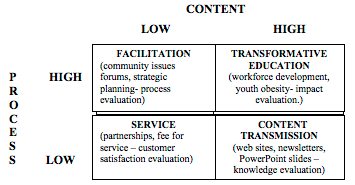Hi! My name is Nancy Franz, and I am a Professor and Extension Specialist at Virginia Polytechnic Institute and State University. I’m also the past chair of the AEA Extension Education Evaluation TIG. Today I’ll be sharing some information on different approaches used in extension education evaluation.
Hot Tip: As the figure below illustrates, community educators approach their work in a variety of ways. This model created by Dr. Merrill Ewert, a past director of Cornell Cooperative Extension focuses on two dimensions – process and content (Franz, 2002). Process refers to the methods used to deliver educational programs and content refers to the information shared that helps change learner’s knowledge or behavior. Combining these dimensions presents four domains that describe the ways extension work is conducted.
The first domain, “service,” includes functions conducted by educators that bring learners to the organization to help them solve a short term problem. Educators using this approach provide little process or content in delivering these services but find this work an important approach to building relationships with clientele groups and addressing basic clientele needs. Evaluation tends to focus simply on customer satisfaction with the service.
The second approach to community education, “facilitation,” finds educators serving as facilitators of group processes in educational settings rather than delivering content or information. Educators may facilitate public forums on community issues or strategic planning sessions for groups. Process evaluation is most appropriate for these efforts.
“Content transmission” as an educational approach focuses on the development and distribution of information including newsletters articles, web-sites, PowerPoint presentations and other resources. Evaluation with this approach most often focuses on knowledge gained from the information disseminated to learners.
The “transformative education” approach to education takes place when educators develop long-term educational relationships with clientele and focus on changes in learning and behavior that leads to change in social, environmental, and economic conditions (Franz, 2002). These efforts are intentionally designed to reach learners over time to address important issues rather than providing one-time educational events. Learners gain new competencies, apply what they’ve learned to their personal context, share results with each other, and adjust their application of learning as needed. This approach to community education most often focuses on impact evaluation to determine what changes have happened for learners, families, communities and organizations as a result of the educational program.
For more information, see Franz, N. (2002), Transformative learning in intraorganizational partnerships, Unpublished doctoral dissertation, Cornell University, Ithaca, NY.
This week’s posts are sponsored by AEA’s Extension Education Evaluation Topical Interest Group (http://comm.eval.org/EVAL/Extension_Education_Evaluation/Home/Default.aspx) as part of the EEE TIG Focus Week. Check out AEA’s Headlines and Resources entries (http://eval.org/aeaweb.asp) this week for other highlights from and for those conducting evaluations in an Extension Education context.

